Quentin Tarantino is quickly ascending my list of favorite directors: I doubt he's going to trump Coppola or Hitchcock anytime soon, but he's getting there. While I think both Inglourious Basterds and Reservoir Dogs are above average outings, Pulp Fiction is one of my personal favorite movies - in my top 20, in fact. I was somewhat hesitant when approaching the Kill Bill series, knowing that the series is notorious for its massive amounts of violence and gore, but, my trepidations set aside, I sat down and enjoyed the pictures. After watching them, both rank under Pulp Fiction, but I think each is stronger than Basterds or Dogs. I watched these movies over the course of two consecutive nights, an arrangement I felt gave enough time for me to digest the movie experience in full. Some have told me that watching the two films jointly is an even better experience, but I have my hesitations. A few moments in Kill Bill Vol. 2 don't mesh perfectly with the ending of Kill Bill Vol. 1. As a result, I prefer to look at the two as sequels rather than as one film divided in two.
So, without further ado, let's begin the comparison.
1. The Bride
Choosing which film handles the Bride better is mostly dependent on what the Bride has to go through. In the first film, we see the Bride at her greatest physical vulnerability. She has just recovered from her gunshot wound, she has been drugged and raped whilst in a coma, and she can hardly move her legs. As the film goes on, the challenges just get tougher and tougher. The forces of O-Ren Ishii prove to be the most lethal opponent's of the Bride, leaving her battered and bloody after several fatiguing fights. Plus, since the Bride is barely given a chance to speak in this film, her acting is almost wholly reliant on body language. It's still communicated masterfully, but the part clearly has its limits.
I think we see a greater depth to the character in Kill Bill Vol. 2. For, instead of being physically vulnerable, the Bride is now emotionally vulnerable. Her daughter, long believed to be dead, is alive and at the mercy of the man the Bride trusts the least: Bill. Bill himself knows the Bride's personality forwards and backwards: he knows exactly what strings to manipulate. The Bride is also given more dialogue, allowing Thurman to communicate with all her acting skills, not just the silent ones. She has more roles to play, having to play the mother, lover, student, as well as the avenger. And, since Thurman does such a good job with all of these roles, we come to respect the character as a fully three-dimensional one.
The Bride is certainly good in Kill Bill Vol. 1, but Kill Bill Vol. 2 just has more depth with regards to its main character.
Vol 1: 0
Vol 2: 1
2. Villains
The overarching villains of the Kill Bill saga are the members of the Deadly Viper Assassination Squad, a group of elite killers headed by Bill and of which the Bride was once a member. For this section, however, I will only be focusing on the main villainous force in each movie: the other members of the DVAS will be included in the next category. Let us then focus on the primary villains of Kill Bill Vol. 1 and Kill Bill Vol. 2: O-Ren Ishii and Bill.
O-Ren Ishii, played by Lucy Liu, is one of the members of the DVAS and the reigning leader of the Yakuza. The only survivor of her family's massacre by a Yakuza boss, Ishii works her way up to being one of the world's top assassins. With Bill's help, she quickly climbs her way through the Yakuza ranks to take it over, even though she is not 100% pureblood Japanese. Ishii is a capable commander with keen organization skills, but she is utterly ruthless when it comes to questioning her blood. She is one of the single most difficult opponents for the Bride to take down, managing to inflict severe wounds upon the Bride during their fight. On the downside, many have complained that Liu's performance is rather wooden. She isn't given too much time to display her full range of emotions.
Contrast this with Bill, played by David Carradine. The leader of the DVAS, Bill is the Bride's former lover as well as one of her mentors. He is alarmingly intelligent, able to understand and manipulate others with ease. He is the single toughest emotional obstacle for the Bride to overcome, using the Bride's daughter (his own) as a bargaining chip to tide over the inevitable. He is seemingly kind but is all too aware of the killer instincts within himself. He is an excellent fighter but doesn't feel the need to display his abilities. He is soft-spoken, collected, and ready to face any challenge.
Based on the two descriptions and the plot summary I've thus far provided, it appears that Bill should win this contest hands down. I'm not so sure. For Bill's motivation is quite lacking indeed. The reason Bill orders a hit on the Bride is his being impulsive and jealous over her marrying another man; is that really just cause to murder eight people during a wedding rehearsal? This apparently makes Bill all the more cold-blooded, but, in my view, it makes him all the more childish and immature. Bill's soft-spokenness also leaves his lines somewhat monotonous in expression, even if his lines are engaging.
Ishii, in my opinion, actually demonstrates tremendous subtlety for a villain, for Liu's blankness makes Ishii more compelling. In her final battle, she manages to keep an almost completely emotionless face, putting her in line with the principles of bushido. She is clearly not afraid to die, even if she thinks herself superior to the Bride in combat. She displays an elegance and grace in her combat, allowing the action of Kill Bill Vol. 1 to add even more to her character. Her motivations are more believable. Her arc is a bit more organic. Thus, when her duel with the Bride comes to a close, we find that she is a far more honorable and important opponent for the Bride to face than even Bill himself.
Bill may be the leader, but Ishii really is the best member of the DVAS.
Kill Bill Vol. 1: 1
Kill Bill Vol. 2: 1
3. Side Characters
 |
| Gogo - Kill Bill Vol. 1 |
 |
| Vernita Green - Kill Bill Vol. 1 |
 |
| Elle Driver - Kill Bill Vol. 2 |
 |
| Pai Mei - Kill Bill Vol. 2 |
The original Kill Bill has quite a cast of fun, minor characters. Sofie Fatale, played by Julie Dreyfus, is a nice incarnation of the cowardice and weakness we are supposed to universally loathe, from the perspective of both the heroes and the villains. Buck, played by Michael Bowen, is a disturbing male nurse turned rapist, who gets his just desserts for his most loathsome of crimes. Better than both is Vivica A. Fox as Vernita Green. The sassiest member of the DVAS, Vernita is our first introduction to the insane fight choreography of the series. A former assassin turned family woman, she manages to be exactly what the Bride wants to be and loathes the most: she is a proud mother with a stable family, but she uses her family as little more than a bargaining tool.
But my personal favorite has to be Gogo Yubari, played by Chiaki Kuriyami. Putting it bluntly, this girl is bats*** crazy. One of the most lethal henchmen in movie history, Gogo is a psychotic schoolgirl wielding a meteor hammer that nearly manages to kill the Bride. Indeed, she's one of the closest characters to actually killing the Bride in the entire series. Her combat is also ridiculously sexualized, as she seems to derive orgasmic pleasure from fighting. The role is so ridiculously hammy and over-the-top that it's impossible not to fall in love with it. Not to mention, the fight between her and the Bride is the best in the entire saga.
This is not to say Kill Bill Vol. 2 doesn't have a good supporting cast. Christopher Allen Nelson makes a brief appearance as the Bride's groom-to-be, Tommy Plympton; his role is short but effective. Less than stellar is Daryl Hannah as Elle Driver. The least likable of the DVAS, Driver is psychotic without any of the ham. She is needlessly narcissistic, shows little to no respect for her opponents, and plays dirty constantly. The audience quickly dislikes her from the instant she appears, for we know the Bride deserves a much better rival. I've not liked Daryl Hannah in a single role I've seen her in; this time is no different. Fortunately, the Bride's teacher, Pai Mei, as performed by Gordon Liu, more than makes up for Driver's lack of grace. A man so skilled at martial arts that he is able to use every part of himself (and I do mean every part) as a weapon, Pai Mei is arrogant in all the right ways. He is funny and threatening at the same time.
 |
| Budd - Kill Bill Vol. 2 |
Though the characters of Kill Bill Vol. 1 are a lot of fun, not one of them is as complex as Budd. So, the drunk guy nails the sequel a point.
Kill Bill Vol. 1: 1
Kill Bill Vol. 2: 2
4. Action
Here's where things get bloody. Ridiculously bloody. The Kill Bill franchise has more limbs hacked off within it than within Ed Gein's house. The question here is which movie handles this violence more tastefully, has better fight choreography, and just has a better handle on its action.
It's a rare sight to find combat as meaningful in any movie; more often than not, it's but a special effect added to wow the audience rather than evoke an emotional response. But there's something I call "narrative through combat," in which the fight choreography is able to explain the characteristics of a person and tell the story without dialogue. It's one of my favorite things found in movies, as expertly demonstrated in The French Connection, Crouching Tiger, Hidden Dragon, and Warrior. The Kill Bill series manages to exhibit "narrative through combat" rather consistently, with only a few minor flubs here and there.
Kill Bill Vol. 1 certainly has much more fighting and violence than the sequel. Within the first movie, we see people cut in half, scalped, bludgeoned to death, hemorrhaged to death, stabbed, mutilated, decapitated, gunned down - there's no shortage of violence. And Tarantino doesn't spare us the detail; we see every drop of blood. The image of Gogo's eyes bleeding still gives me chills. One has to wonder if the violence is somewhat gratuitous. Some would say "yes," but I'm not one of them. To me, the violence of Kill Bill Vol. 1 crosses the line twice. At first, it's disgusting and almost gratuitous. But, since the movie keeps up the violence and keeps finding new ways to stylize it, it manages to cross the line back into non-gratuity. The sheer insanity of the fighting makes it more enjoyable and more artistic. Special mention must be given to the fights between the Bride and Gogo, arguably the best fight in the entire franchise in terms of pure fight choreography, and the battle between the Bride and O-Ren, pitting the principles of bushido against the natural fury of a vengeful murderess.
Kill Bill Vol. 2 tries to restrain itself. Whereas the original Kill Bill has at least nine full fight sequences, Kill Bill Vol. 2 only has four, none of which are as lengthy as those in the first. At the same time, each of these fights serves to tell a different part of the story. The Bride vs Budd fight demonstrates the evolution of warfare, while the Bride vs Pai Mei fight shows us a totally new side to the Bride - her as a student. The highlight is the Bride vs Elle Driver fight, if only because the audience wants to see Driver die painfully. The ending is both shocking and disgusting; unfortunately for Kill Bill Vol. 2, the lack of consistency in its violence make the gore of this final fight somewhat gratuitous. It doesn't have the chance to cross the line twice. At the same time, the conclusion is quite poetic in its execution, with the fast editing contributing to the shock.
Since both movies clearly demonstrate the virtues of "narrative through combat," this point really comes down to the fight choreography. On that basis, I have to hand it to Kill Bill Vol. 1. While the combat of Kill Bill Vol. 2 is well-executed, it is often performed in very enclosed spaces. As a result, the movements become much less fluid. It's tonally appropriate but not as enjoyable to watch. In this category, Kill Bill Vol. 1 cuts down the competition.
Kill Bill Vol. 1: 2
Kill Bill Vol. 2: 2
5. Pacing/Narrative Structure
Tarantino is the master of non-linear cinematic narrative. Pulp Fiction is said to be the most influential film of the 90s due to its perfection of non-linear plot structures. But, being honest, Tarantino has been using this same technique since Reservoir Dogs. Both Kill Bill movies feature some degree of non-linear narrative; the question is: which is more creative and more focused?
Kill Bill Vol. 1 starts us, like the great Homeric epics, in medias res. The Bride is off to kill the second on her hit list, having already defeated O-Ren. The movie then brings us up to speed, telling the preceding story. There is a brief diversion in Chapter Three, in which we hear the background of O-Ren, but we return right back to the present after that. We end the movie as we began, with the Bride off to hunt down Vernita Green, but with new information at hand.
Kill Bill Vol. 2 cuts to immediately after the Bride has killed Vernita and is off to kill Bill. The film then cuts to events prior to those of the first movie, giving us the exact details of what happened before the Bride was shot down. We then travel to the Bride's taking down Budd and Elle, before immediately proceeding to her hunt and takedown of Bill. Then, in full Homeric fashion, we return to the center and finish the story.
Despite all the hopping, not once does the story ever seem confusing. The tidy chapter structure of the saga also contributes to a steady pace. Thus, determining the winner in this category is going to come down to the nitpicks. Personally, I wish we could have spent a bit more time in the last chapter, Face to Face. Since Bill is the final member of the DVAS, it would have been nice had the joust between him and the Bride been a little bit longer. It's a small point and is almost entirely dependent on the plot of the second story, but it's enough to tilt this category in favor of the first Kill Bill.
Kill Bill Vol. 1: 3
Kill Bill Vol. 2: 2
6. Writing/Dialogue
If Kill Bill Vol. 1 barely squeaks by in the last category, Kill Bill Vol. 2 takes this category in a landslide. Sure, Kill Bill Vol. 1 has some fun lines (i.e. "Silly Caucasian girl likes to play with samurai swords" and "I should have been mother******* Black Mamba"), but none of these even come close to the material in Kill Bill Vol. 2. The second Kill Bill movie features classic Tarantino dialogue: pop culture references, pointed and direct sentences, character development through non-cliché writing. It just works in all the right ways. My personal favorite is Bill's analysis and critique of Superman: not only is it an interesting consideration of America's quintessential superhoro, but it also manages to reflect Bill's consideration of himself as compared to the other members of the DVAS and to the world at large. Each line and delivery has much more at stake in the second Kill Bill: an easy win for the sequel.
Kill Bill Vol. 1: 3
Kill Bill Vol. 2: 3
7. Lighting/Camera/Sound
These elements aren't talked discussed too much in most film comparisons, but I think they warrant discussion. After all, the films that make it onto the critics' Sight and Sound poll of the best films of all time usually land there due to their camera and sound work rather than their story. This category will try to examine which film uses the camera, lights, microphones, and all the other fineries of film better.
It's important to keep in mind that the two Kill Bill movies, especially the first, are heavily influenced by Eastern action films. Movies like Battle Royale (also the inspiration for The Hunger Games) showcase many similar filming styles to those seen in Kill Bill Vol. 1. So, not all the creative moves in these movies can directly be attributed to Tarantino. All the same, he manages to pull off some pretty impressive shots. The fight scenes in the House of Blue Leaves pull off some intense shots; the animated .gif you see above shows one of the best low angle shots I've ever seen. The framing is exquisite. The first film also nails its close-ups, with the reveal of O-Ren Ishii's demise being both brutal and beautiful at the same time. The second film's best shots come into play during the Bride's burial and her confrontation with Elle. Both of these moments are very claustrophobic, and the camera perfectly reflects that claustrophobia.
The sound is crisp and well edited throughout all these movies. The soundtrack, as usual in Tarantino's movies, is great, with a wide range of European, Latin, and Eastern tracks. Personally, I think Kill Bill Vol. 2 uses sound a little bit better. During the Bride's burial sequence, we don't see anything. We just hear it. At the end of the day, it's a much more effective scene due to much of the action being left to the viewer's imagination.
That little bit of sound turns the tide in favor of the sequel.
Kill Bill Vol. 1: 3
Kill Bill Vol. 2: 4
8. Suspension of Disbelief
You might call this section the "nitpick" part of the analysis. Whichever movie gets by with fewer plot holes and personal issues gets the edge.
Kill Bill Vol. 1
- If Vernita Green knew she was better with an edged weapon than the Bride, why didn't she just wait until nightfall to fight? Did she really think that the Bride wouldn't expect a sneak attack?
- How the heck can a mass murdering woman escape the authorities when she's driving a truck with a giant "Pussy Wagon" label on the back?
- Couldn't the Bride have just taken one of Hattori Hanzo's other swords rather than have him break his vow to make a new one?
- If O-Ren Ishii is an expert marksman, why does she use a sword?
- In fact, why does anyone in these movies use a sword? Wouldn't it be smarter to just use guns?
- Biggest plot hole: how the hell did the Bride even survive getting shot straight to the head?
Kill Bill Vol. 2
- So the Bride hides under Budd's trailer, allows him, unarmed, to walk into his trailer, waits until he gets his shotgun and positions himself in front of the door, and then barges in to kill him? Shouldn't that have been a big tip off?
- How did Elle Driver get the black mamba into the briefcase to start with?
- So, both the Bride and Elle manage to have a full fight scene in a small trailer while a black mamba is in the same confined space and neither of them gets bitten? Especially when black mambas are notorious for their aggression, speed, and willingness to attack humans if threatened in the slightest way?
- Why would Bill keep in contact with someone who could sell his location out when he knows the Bride has tracked down everyone else?
- Really, Bill murdered 8 people because he was jealous? Also, why didn't he realize the Bride could have been pregnant the whole time?
- Also, why is Bill still killing people? I know it's his "nature," but he's so rich he doesn't need to do it any more. It's apparent that he's a good father; why not just retire, marry the Bride, and spend the rest of one's life reading and analyzing Superman comic books?
- Biggest plot hole: the grave scene... just the grave scene.
- Assuming the Bride did learn how to break a solid 4-inch board from three inches away, that's only under the conditions of air being on the other side. This board has at least 4 feet of dirt on the other side.
- Even if she broke the board, there's no way she could have broken a hole through it. That would require her breaking it multiple times, two times of which she would have had to break the wood against the grain.
- Making the hole would use up more energy and air than would be available in the casket.
- Even if she somehow made a hole and still had energy, the dirt would pour through the hole and crush her before she could even get her hand free, let alone her entire body.
- Even if she somehow managed to get her body through the hole before she suffocated, she would have had to dig straight up using only her hands through at least 4 feet of dirt, all without taking a breath.
- AND, if she somehow managed to get out of the hole, after all that, her hand would be broken. Therefore, how could she have fought off and killed Elle without going to the hospital?
Point to the original.
Kill Bill Vol. 1: 4
Kill Bill Vol. 2: 4
9. Themes
The battle of which film has better themes is a match between subtlety and relevance. Namely, Kill Bill Vol. 1 manages to showcase several subtle themes, but said themes amount to very little, whereas Kill Bill Vol. 2 throws subtlety out the window in favor of a much more important message. This is a difficult battle between two things I greatly value in themes, so it's going to come down to the wire on this one.
Kill Bill Vol. 1 is, at its heart, a revenge story. Revenge is the single engine behind the Bride's behavior. She does not kill to survive or to even live: she kills out of pure, untempered rage. The same notion of revenge applies in her rival, O-Ren Ishii, who murders her family's killer. After the Bride kills Vernita Green, she tells Green's daughter that she can seek revenge once she is old enough. The most profound element about this cycle of revenge is not that the revenge, in and of itself, isn't satisfying; it's the karma of revenge that makes it undesirable. Sure, one might feel the satisfaction of revenge, but such satisfaction is temporary, as someone will mount a reprisal. I also appreciate the subliminal conflict between East and West that's at the heart of Kill Bill Vol. 1's final chapter: at first, both the Bride and O-Ren Ishii are far too overconfident in their own native styles. Eventually, the two come to terms with each other's differences as they fight each other. There's an odd cultural unity to the film, with immense respect for both Eastern and Western fighting styles.
All of these themes are very subdued, though, and only really come forth after much analysis. Also, I find it questionable how applicable these themes really are. Sure, the discussion of revenge is interesting, but do rewal people honestly go around killing dozens of others in order to gain revenge? Furthermore, since "revenge is bad" is a theme so ingrained in our consciousness, in both Western and Eastern politico-religious thought, the point seems somewhat redundant. The other themes of the first film can be written off as homages to previous films of the Eastern canon, as well.
I'm not sure the themes of Kill Bill Vol. 2 can be written off so easily. Not only does the sequel expand upon the themes of the first, bringing the entire karma-revenge cycle full circle, but it also adds in a new theme: motherhood. Most, if not all the Bride's actions, can be likened to what a mother is willing to do for her child. When a mother truly cares about her kin, there is no force in the world that can stand in her way. The only issue here: the movie highlights this theme with all the force of a sledgehammer. It even spells the theme out for the audience with not so subtle symbolism and a written moral. It's somewhat irritating. At the same time, it's an idea that does leave a moral impact, unlike those of the first film. The maternal instinct is something we don't really examine too much in movies. And, since the Bride clearly wants her baby and wants her baby to live a non-murder filled life, her decisions don't come across as Tarantino-based sexism at all. They come across as indicative of sacrifice: positive character development. The Bride's choosing to abandon her murders and become a mother doesn't make her less of a role model; it makes her more of one. (After all, how many katana-wielding psychopaths do you look up to?)
Chalk up another point for the sequel.
Kill Bill Vol. 1: 4
Kill Bill Vol. 2: 5
10. Creativity
Out of all the categories, this was the easiest to determine. Kill Bill Vol. 1 takes far more risks than Kill Bill Vol. 2. Not only does Tarantino have to abandon his signature element, his dialogue, but he also has to experiment with many different filming styles and artistic mediums. There are intense action scenes shifting from black and white to color, battles shifting from full volume rock music to dead silence, split screen moments focusing on suspense and build-up, even an entire chapter that is animated in a combination of anime and sketch textures. Kill Bill Vol. 2 falls back upon most of Tarantino's familiar elements: violence and witty dialogue. It's not that these things are bad, but none of them really test the boundaries of film as a medium.
Kill Bill Vol. 1: 5
Kill Bill Vol. 2: 5
11. Story
The contest ultimately had to come down to which movie told a more focused, important, effective, and cohesive story. Once again, this was a difficult choice to make. It came down to a question of urgency: which film really felt more in the moment? Which film understood how to make each moment matter all the more? After much deliberation, I had to side with Kill Bill Vol. 2.
As I mentioned in the first category, while Kill Bill Vol. 1 is about the Bride's physical peril, Kill Bill Vol. 2 is about her emotional peril. Emotional peril has far greater storytelling prospects than mere physical peril. In fact, all of the Bride's conflicts in the second film have a far greater punch. The conflict with Budd has more emotional weight because Budd is the one person truly able to beat the Bride. The fight with Elle has more gravitas because the Bride and Elle really do despise each other, something not present in the other fights. And the final confrontation with Bill, even if somewhat underwhelming, does explore most of the emotional issues at hand. The characters are constantly developing, even if they aren't necessarily the most likable or the subtlest.
Furthermore, Kill Bill Vol. 2 does seem much more comfortable in its story than the first Kill Bill. Much of the creativity of the first Kill Bill, what with the animation and different camera, seems like it is compensating for the lack of emotional and plot complexity that's present in the second. Certainly, said creativity does add a great deal to the story, but it can't fully make up for the limitations Kill Bill Vol. 1 places on itself.
Even if I enjoyed Kill Bill Vol. 1 a bit more while watching it, I think, if I watched these movies 2-3 more times, I'd probably find myself gravitating towards the second. Much more is at stake, the story is much more focused, and there's just a little bit more to be found. In this case, the sequel is better than the original.
The winner is:
I give Kill Bill Vol. 1 8.2 stars out of 10 and Kill Bill Vol. 2 8.5 stars out of 10.

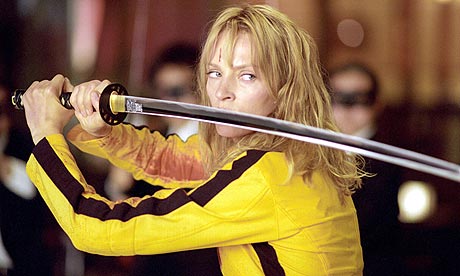

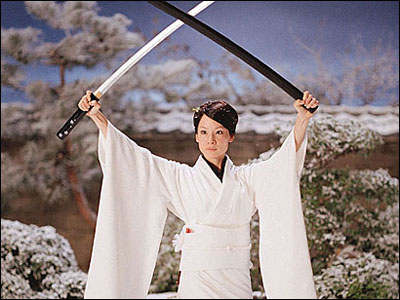

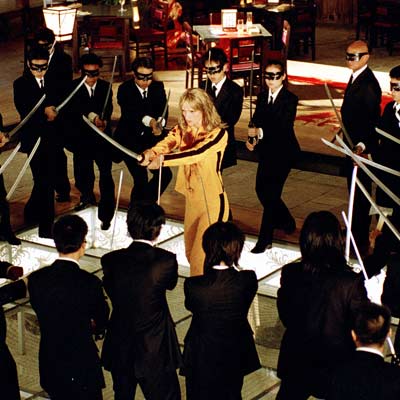
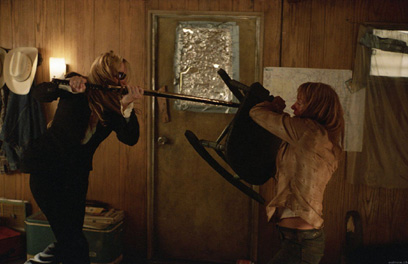


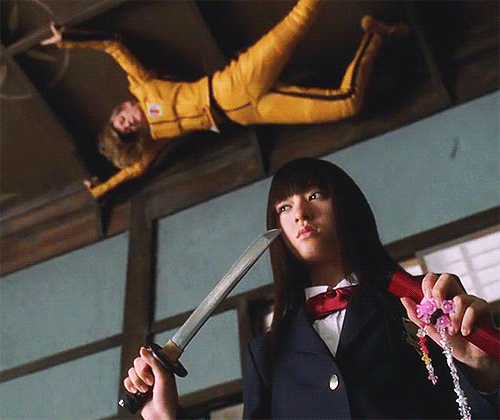





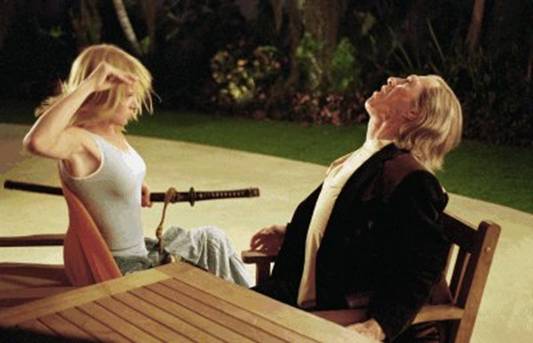
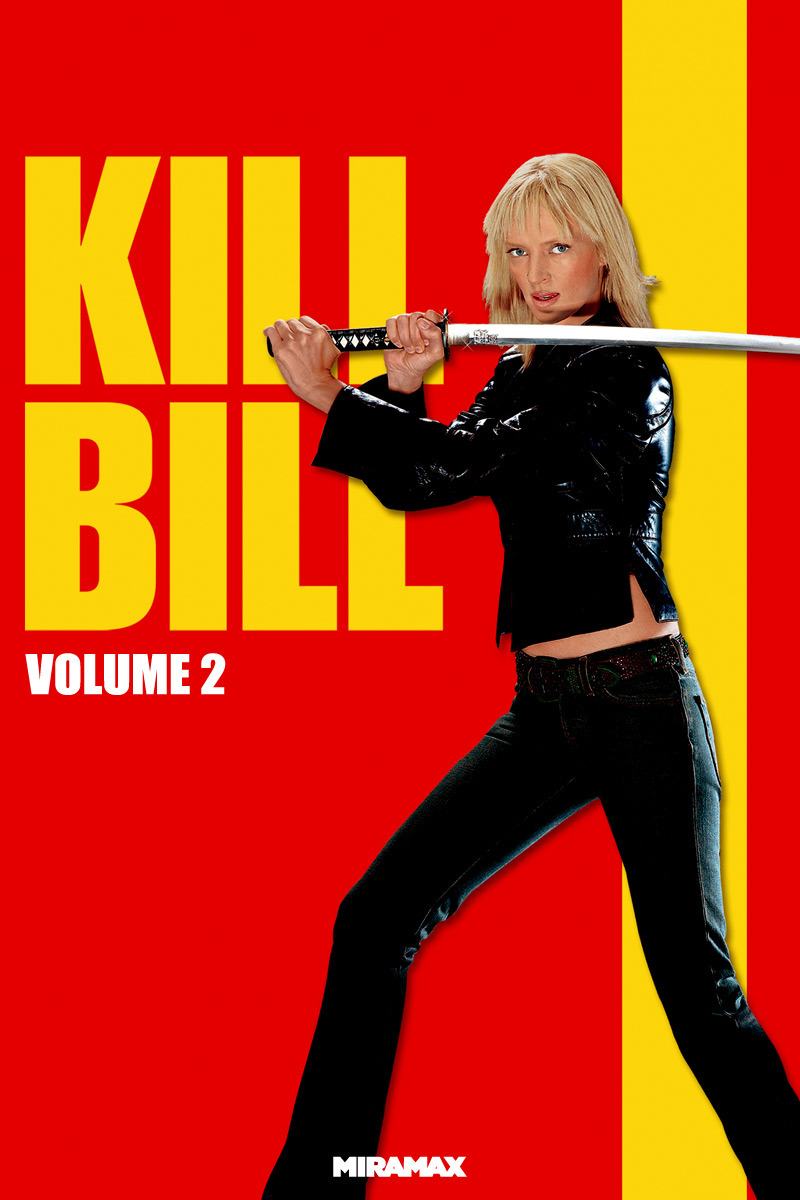
No comments:
Post a Comment
All comments posted on this blog should be framed in a civil manner. Constructive criticism is more than welcome (feel free to mock a typo here, a misreading there, a lack of understanding there). But, for sake of the written word, do try to use proper grammar.